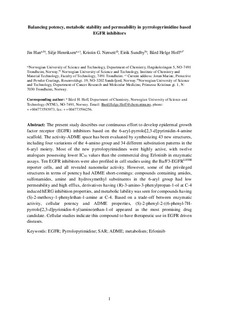Balancing potency, metabolic stability and permeability in pyrrolopyrimidine-based EGFR inhibitors
Journal article, Peer reviewed
Date
2016Metadata
Show full item recordCollections
- Institutt for kjemi [1353]
- Publikasjoner fra CRIStin - NTNU [37221]
Original version
European Journal of Medicinal Chemistry 2016, 124:583-607 10.1016/j.ejmech.2016.08.068Abstract
The present study describes our continuous effort to develop epidermal growth factor receptor (EGFR) inhibitors based on the 6-aryl-pyrrolo[2,3-d]pyrimidin-4-amine scaffold. The activity-ADME space has been evaluated by synthesizing 43 new structures, including four variations of the 4-amino group and 34 different substitution patterns in the 6-aryl moiety. Most of the new pyrrolopyrimidines were highly active, with twelve analogues possessing lower IC50 values than the commercial drug Erlotinib in enzymatic assays. Ten EGFR inhibitors were also profiled in cell studies using the Ba/F3-EGFRL858R reporter cells, and all revealed nanomolar activity. However, some of the privileged structures in terms of potency had ADME short-comings: compounds containing amides, sulfonamides, amine and hydroxymethyl substituents in the 6-aryl group had low permeability and high efflux, derivatives having (R)-3-amino-3-phenylpropan-1-ol at C-4 induced hERG inhibition properties, and metabolic lability was seen for compounds having (S)-2-methoxy-1-phenylethan-1-amine at C-4. Based on a trade-off between enzymatic activity, cellular potency and ADME properties, (S)-2-phenyl-2-((6-phenyl-7H-pyrrolo[2,3-d]pyrimidin-4-yl)amino)ethan-1-ol appeared as the most promising drug candidate. Cellular studies indicate this compound to have therapeutic use in EGFR driven diseases.
